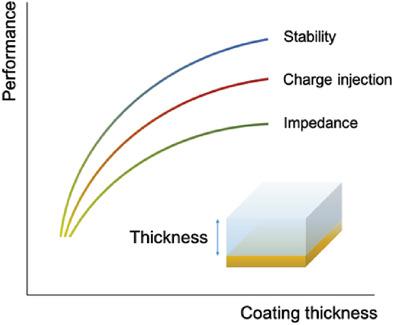当前位置:
X-MOL 学术
›
Adv. Mater. Interfaces
›
论文详情
Our official English website, www.x-mol.net, welcomes your feedback! (Note: you will need to create a separate account there.)
Influence of PEDOT:PSS Coating Thickness on the Performance of Stimulation Electrodes
Advanced Materials Interfaces ( IF 5.4 ) Pub Date : 2020-06-22 , DOI: 10.1002/admi.202000675 Gerwin Dijk 1, 2 , Hermanus J. Ruigrok 1 , Rodney P. O'Connor 1
Advanced Materials Interfaces ( IF 5.4 ) Pub Date : 2020-06-22 , DOI: 10.1002/admi.202000675 Gerwin Dijk 1, 2 , Hermanus J. Ruigrok 1 , Rodney P. O'Connor 1
Affiliation

|
Poly(3,4‐ethylenedioxythiophene) doped with polystyrene sulfonate (PEDOT:PSS) is a conducting polymer commonly used to coat the electrodes of biomedical devices to reduce impedance and improve charge injection. The stimulation performance of such electrodes depends on coating thickness due to the volumetric properties of the conducting polymer. Here, the influence of PEDOT:PSS coating thickness on impedance, charge injection, and electrode stability is examined. The results show that stacking spin‐coated layers is a reliable method to control coating thickness without introducing electronic or ionic blocking elements in between layers. Besides improving the polymer‐electrolyte interaction due to a higher capacitance, thicker coatings can endure more stimulation pulses and withstand higher voltages without loss of performance, thus enhancing the lifetime of the electrode. This work presents fundamental insights into the coupling of PEDOT:PSS coated electrodes with electrolytes and provides guidance in the development of organic bioelectronic stimulation devices for optimum performance and longevity.
中文翻译:

PEDOT:PSS涂层厚度对刺激电极性能的影响
掺杂有聚苯乙烯磺酸盐(PEDOT:PSS)的聚(3,4-乙二氧基噻吩)是一种导电聚合物,通常用于涂覆生物医学设备的电极以降低阻抗并改善电荷注入。由于导电聚合物的体积特性,这种电极的刺激性能取决于涂层厚度。在这里,检查了PEDOT:PSS涂层厚度对阻抗,电荷注入和电极稳定性的影响。结果表明,堆叠旋涂层是控制涂层厚度的可靠方法,而无需在层之间引入电子或离子阻挡元素。除了由于较高的电容而改善聚合物与电解质的相互作用之外,较厚的涂层还可以承受更多的刺激脉冲并承受更高的电压而不会降低性能,从而延长了电极的寿命。这项工作为PEDOT:PSS涂层电极与电解质的耦合提供了基本见识,并为有机生物电子刺激设备的开发提供了指导,以实现最佳性能和寿命。
更新日期:2020-06-22
中文翻译:

PEDOT:PSS涂层厚度对刺激电极性能的影响
掺杂有聚苯乙烯磺酸盐(PEDOT:PSS)的聚(3,4-乙二氧基噻吩)是一种导电聚合物,通常用于涂覆生物医学设备的电极以降低阻抗并改善电荷注入。由于导电聚合物的体积特性,这种电极的刺激性能取决于涂层厚度。在这里,检查了PEDOT:PSS涂层厚度对阻抗,电荷注入和电极稳定性的影响。结果表明,堆叠旋涂层是控制涂层厚度的可靠方法,而无需在层之间引入电子或离子阻挡元素。除了由于较高的电容而改善聚合物与电解质的相互作用之外,较厚的涂层还可以承受更多的刺激脉冲并承受更高的电压而不会降低性能,从而延长了电极的寿命。这项工作为PEDOT:PSS涂层电极与电解质的耦合提供了基本见识,并为有机生物电子刺激设备的开发提供了指导,以实现最佳性能和寿命。


























 京公网安备 11010802027423号
京公网安备 11010802027423号